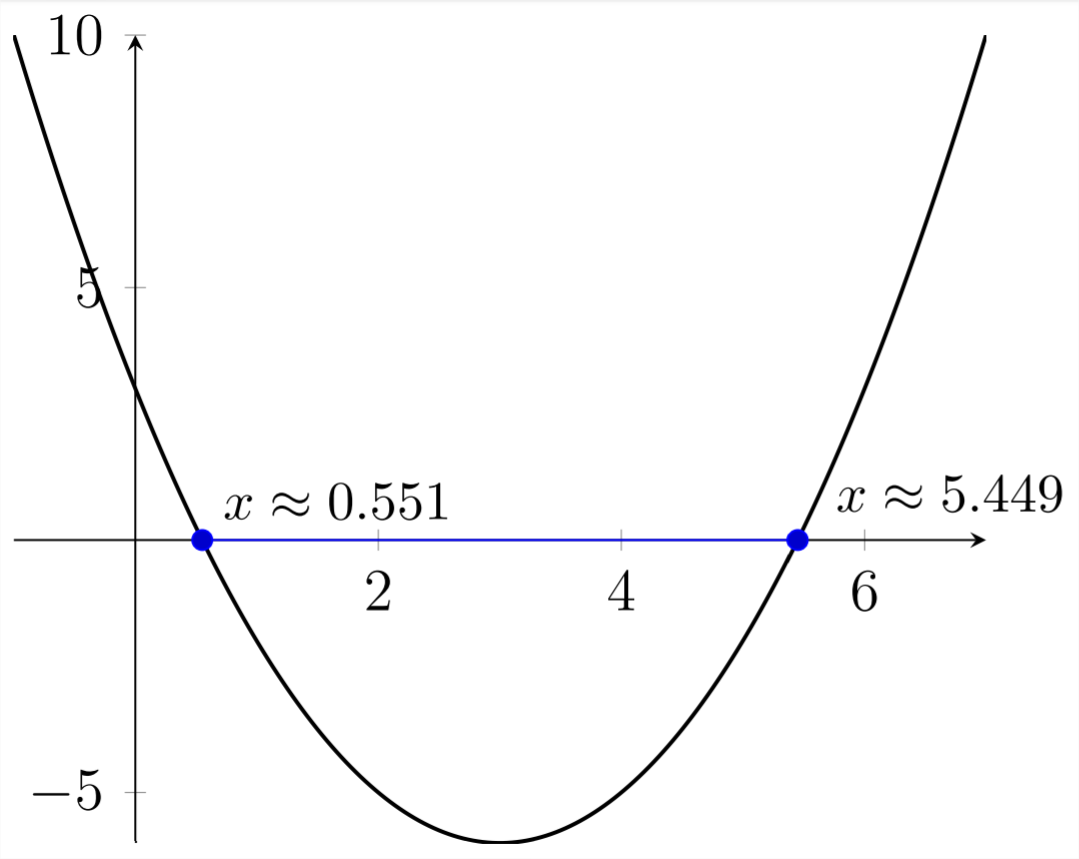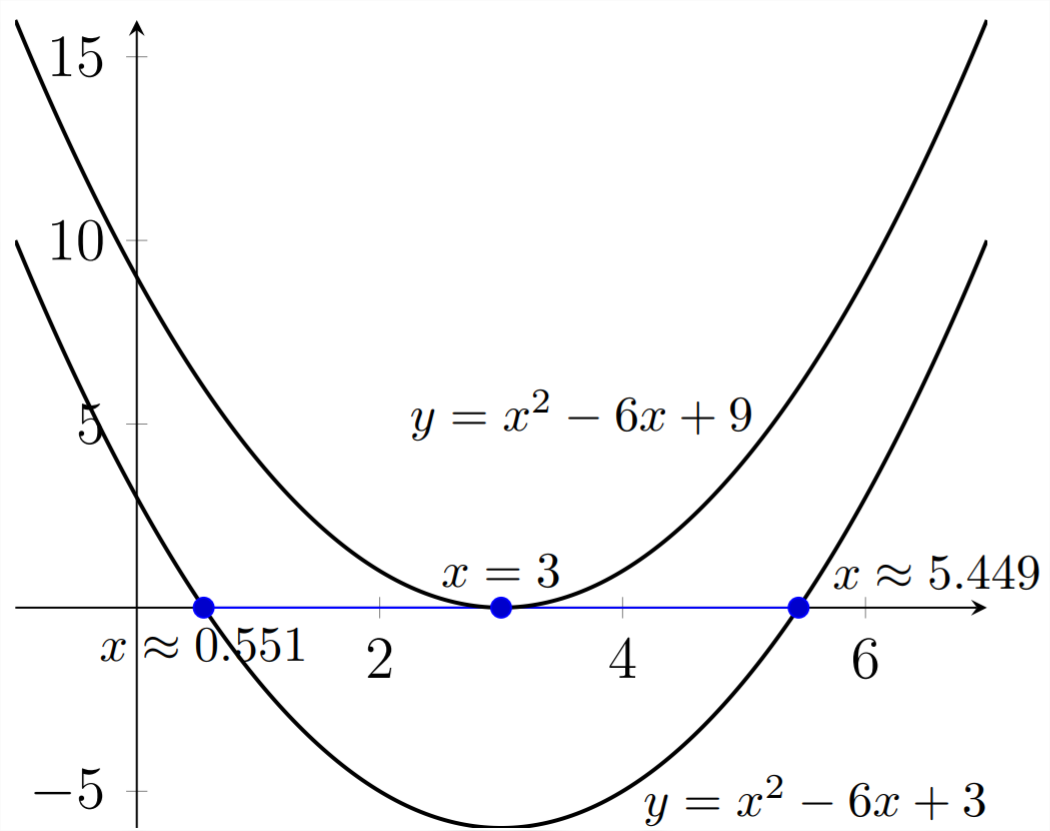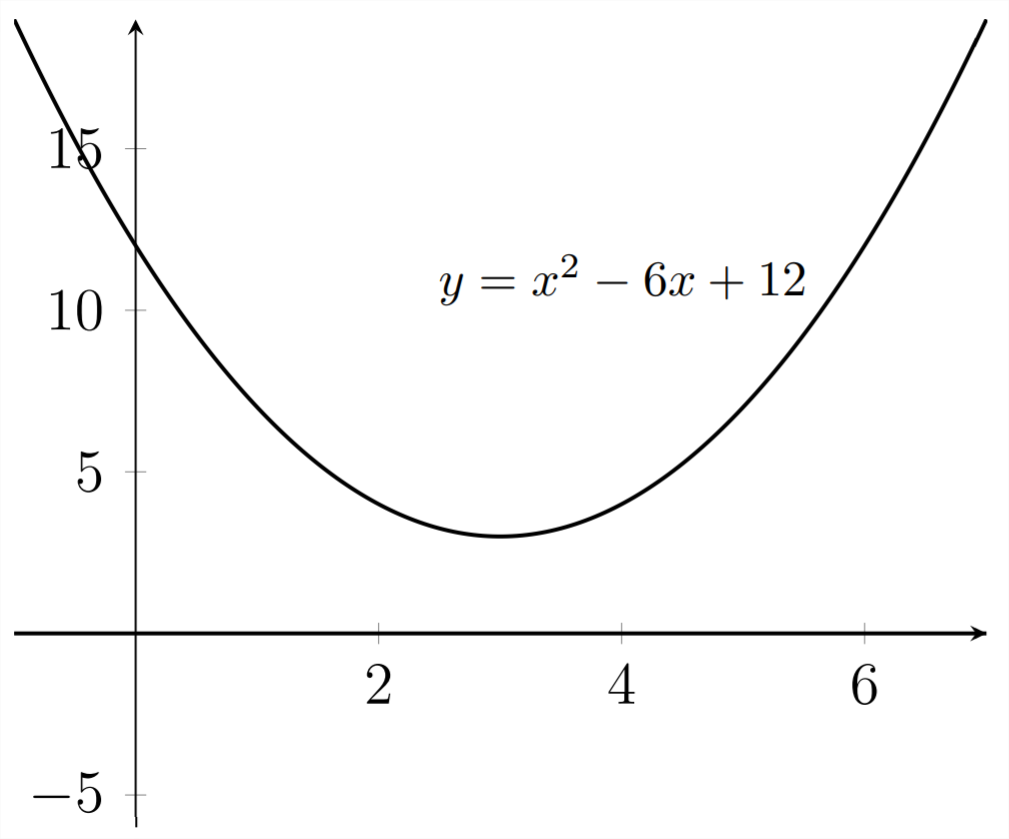1.5: Quadratic Equations with Complex Roots
- Page ID
- 40893
In Section \(1.3,\) we considered the solution of quadratic equations that had two real-valued roots. This was due to the fact that in calculating the roots for each equation, the portion of the quadratic formula that is square rooted (\(b^{2}-4 a c,\) often called the discriminant) was always a positive number.
For example, in using the quadratic formula to calculate the the roots of the equation \(x^{2}-6 x+3=0,\) the discriminant is positive and we will end up with two real-valued roots:
\[
\begin{array}{c}
x^{2}-6 x+3=0 \\
a=1, b=-6, c=3 \\
=\frac{-(-6) \pm \sqrt{(-6)^{2}-4(1)(3)}}{2 * 1} \\
=\frac{6 \pm \sqrt{36-12}}{2} \\
=\frac{6 \pm \sqrt{24}}{2} \\
=\frac{6 \pm 4.899}{2}
\end{array}
\]
\begin{array}{ll}
\approx \frac{6+4.899}{2} & \approx \frac{6-4.899}{2} \\
\approx \frac{10.899}{2} & \approx \frac{1.101}{2} \\
\approx 5.449 & \approx 0.551
\end{array}
When we added and subtracted the square root of 24 to 6 in the quadratic formula, this created two answers, and they were real-valued because the square root of 24 is real-valued.
Another way to see this is graphically. If we graph \(y=x^{2}-6 x+3\) and find the \(x\) values that make \(y=0,\) these will appear along the \(x\) -axis, and will be the same values that solve the equation \(x^{2}-6 x+3=0\)

If we consider a related, but slightly different equation to start with, these relationships between the roots, the discriminant and the graphical intersections will be slightly different.
\[
\begin{array}{c}
x^{2}-6 x+9=0 \\
a=1, b=-6, c=9
\end{array}
\]
\begin{aligned}
x &=\frac{-(-6) \pm \sqrt{(-6)^{2}-4(1)(9)}}{2 * 1} \\
&=\frac{6 \pm \sqrt{36-36}}{2} \\
&=\frac{6 \pm \sqrt{0}}{2} \\
&=\frac{6}{2}=3
\end{aligned}
Because the discriminant was 0 in this problem, we only get one real-valued answer.
Graphically, the additional 6 that was added to the original equation to change it from \(x^{2}-6 x+3\) to \(x^{2}-6 x+9\) shifts every \(y\) value on the graph up 6 units.

If we add an additional three units to the constant term of this quadratic equation, we encounter a third possibility.
\begin{array}{c}
x^{2}-6 x+12=0 \\
a=1, b=-6, c=12 \\
=\frac{-(-6) \pm \sqrt{(-6)^{2}-4(1)(12)}}{2 * 1} \\
=\frac{6 \pm \sqrt{36-48}}{2} \\
=\frac{6 \pm \sqrt{-12}}{2} \\
=\frac{6}{2} \pm \frac{6 \cdot 464 i}{2} \\
\approx 3 \pm 1.732 i
\end{array}
Here the discriminant is negative, which leads to two complex-valued answers. If the equation has real-valued coefficients, the complex roots will always come in conjugate pairs. Complex conjugates share the same real-valued part and have opposite signs in their complex-valued (or imaginary) parts: \(a \pm b i\)
Graphically, the previous problem was one step away from not intersecting the \(x\) -axis at all and the additional three units that we added on to get \(y=x^{2}-\) \(6 x+12\) moves the graph entirely away from the \(x\) -axis. Because the roots are complex-valued, we don't see any roots on the \(x\) -axis. The \(x\) -axis contains only real numbers.

since the calculator has been programmed for the quadratic formula, the focus of the problems in this section will be on putting them into standard form.
Example \(\PageIndex{1}\)
Solve for \(x\)
\((2 x+1)(x+5)-2 x(x+7)=5(x+3)^{2}\)
Solution
\[
\begin{array}{c}
(2 x+1)(x+5)-2 x(x+7)=5(x+3)^{2} \\
2 x^{2}+11 x+5-2 x^{2}-14 x=5(x+3)(x+3) \\
-3 x+5=5\left(x^{2}+6 x+9\right) \\
-3 x+5=5 x^{2}+30 x+45 \\
0=5 x^{2}+33 x+40 \\
x=5, b=33, c=40 \\
x=-5,-1.6
\end{array}
\]
The fact that the roots of this equation were rational numbers means that the equation could have been solved by factoring.
\[
\begin{array}{cc}
0=5 x^{2}+33 x+40 \\
0=(5 x+8)(x+5) \\
5 x=-8 & x+5=0 \\
5 x+8=0 & x=-5 \\
x=-1.6 &
\end{array}
\]
Example \(\PageIndex{1}\)
Solve for \(x\)
\((x-2)^{2}+3(4 x-1)(x+1) &=7(x+1)(x-1)\)
Solution
\[
\begin{aligned}
x^{2}-4 x+4+3\left(4 x^{2}+3 x-1\right) &=7\left(x^{2}-1\right) \\
x^{2}-4 x+4+12 x^{2}+9 x-3 &=7 x^{2}-7 \\
13 x^{2}+5 x+1 &=7 x^{2}-7 \\
6 x^{2}+5 x+8 &=0 \\
a=6, b=5, c=8 & \\
x \approx-0.41 \overline{6} \pm 1.077 i \approx-\frac{5}{12} \pm 1.077 i
\end{aligned}
\]
Exercise \(\PageIndex{1}\)
Solve for \(x\) in each equation. Round any irrational values to the nearest 1000 th.
1) \(\quad 3 x^{2}-3 x=4\)
2) \(\quad 4 x^{2}-2 x=7\)
3) \(\quad 5 x^{2}=3-7 x\)
4) \(\quad 3 x^{2}=21-14 x\)
5) \(\quad 6 x^{2}+1=2 x\)
6) \(\quad 5 x-3 x^{2}=17\)
7) \(\quad (5 x-1)(2 x+3)=3 x-20\)
8) \(\quad (x+4)(3 x-1)=9 x-5\)
9) \(\quad (x-2)^{2}=8 x(x-1)+10\)
10) \(\quad (2 x-3)^{2}=2 x-7 x^{2}\)
11) \(\quad (x+5)(x-6)=(2 x-1)(x-4)\)
12) \(\quad (3 x-4)(x+2)=(2 x-5)(x+5)\)
- Answer
-
1) \(\quad x \approx 1.758,-0.758\)
3) \(\quad x \approx 0.344,-1.744\)
5) \(\quad x \approx 0.1 \overline{6} \pm 0.373 i\)
7) \(\quad x \approx-0.5 \pm 1.204 i\)
9) \(\quad x \approx 0.286 \pm 0.881 i\)
11) \(\quad x \approx 4 \pm 4.243 i\)


